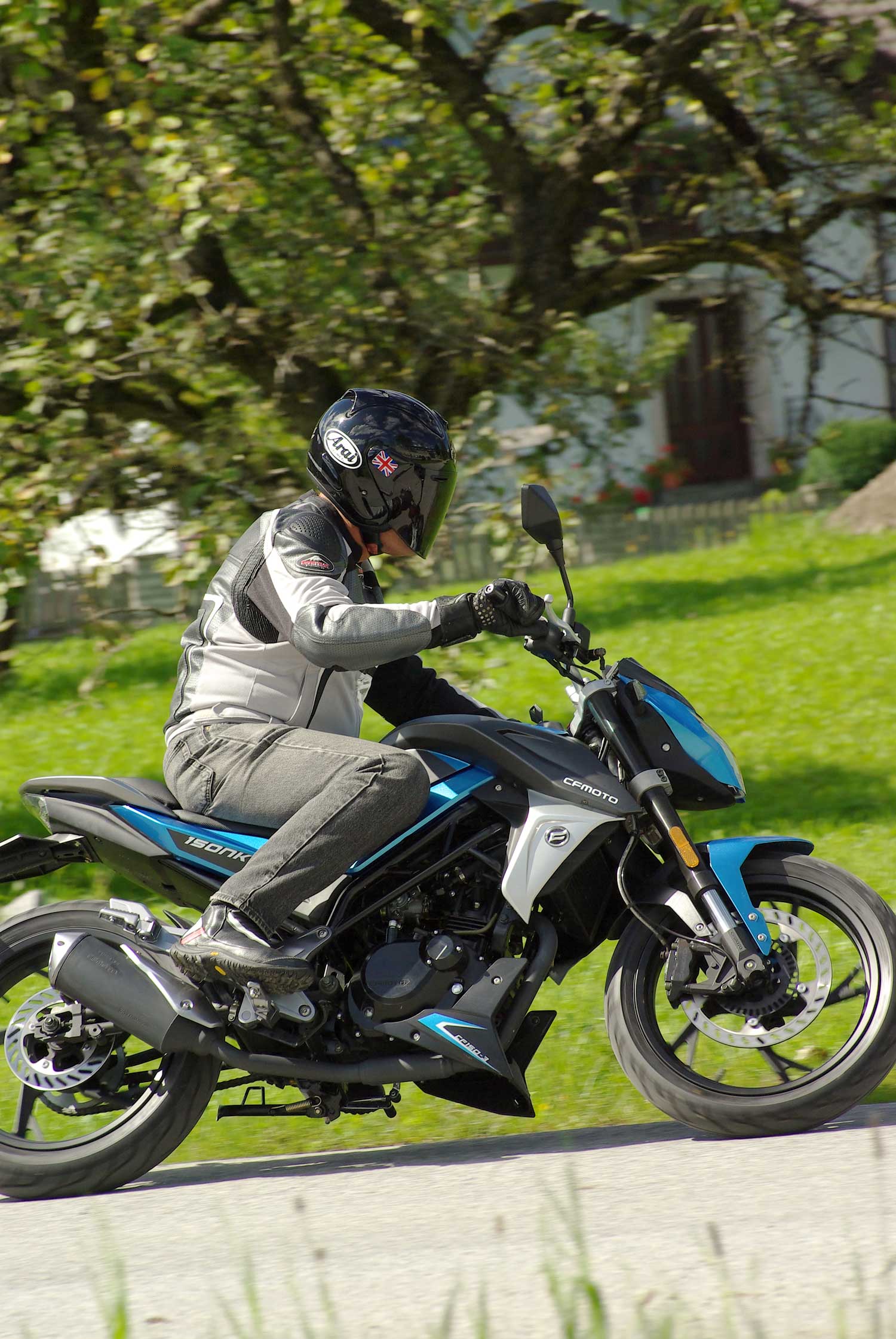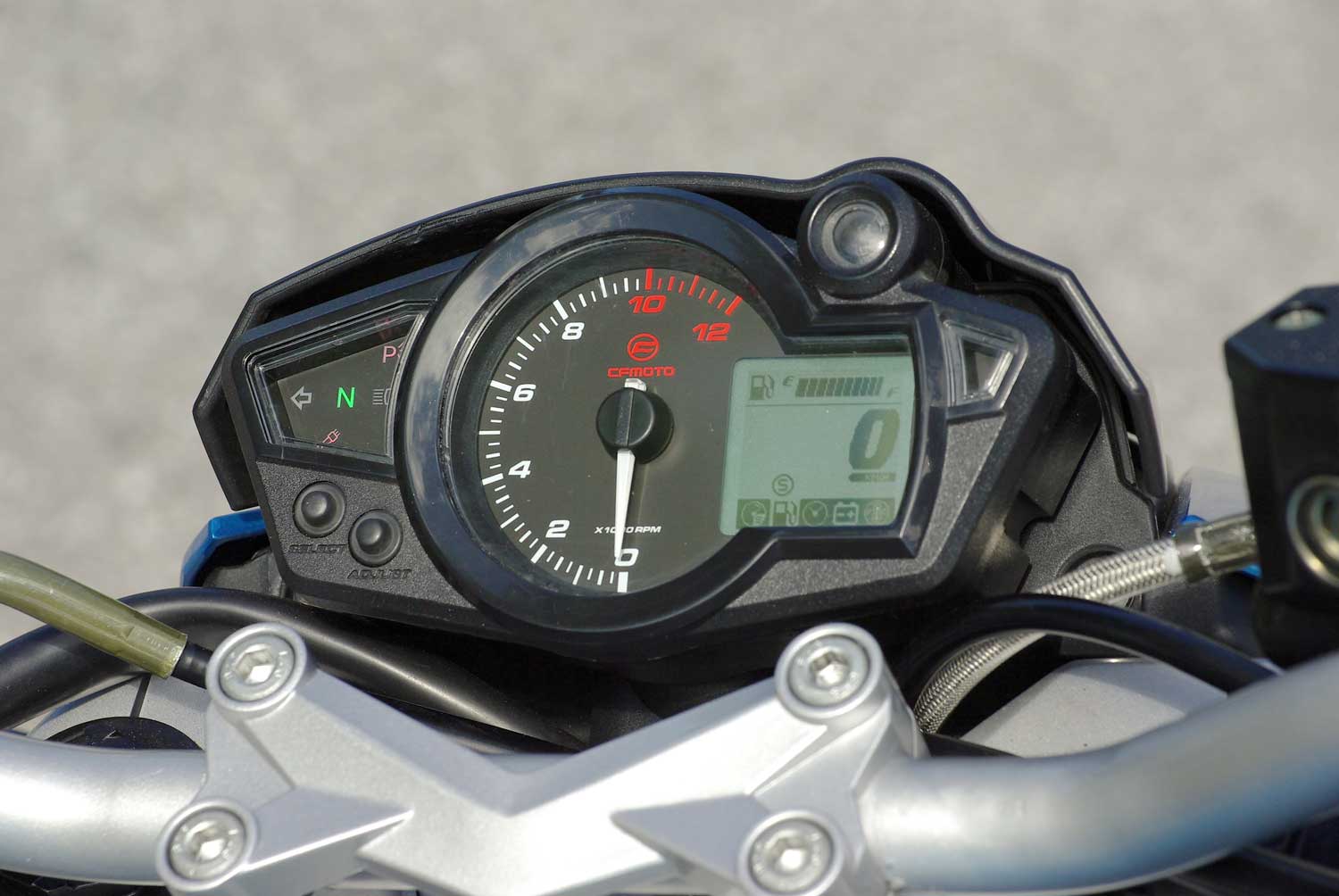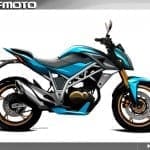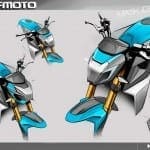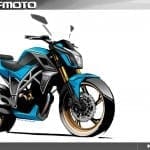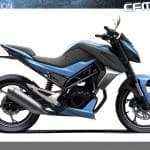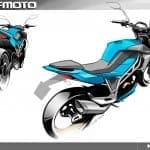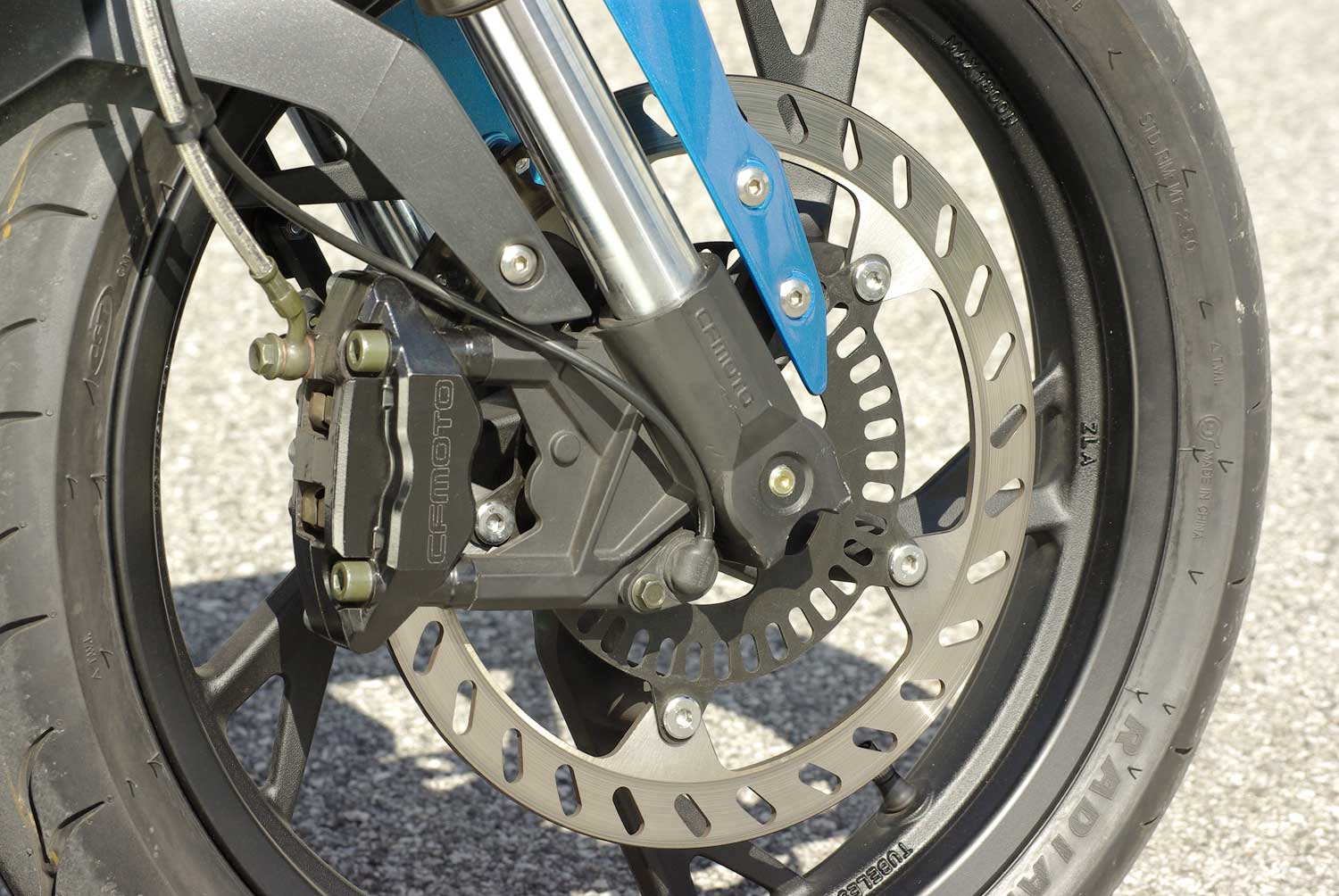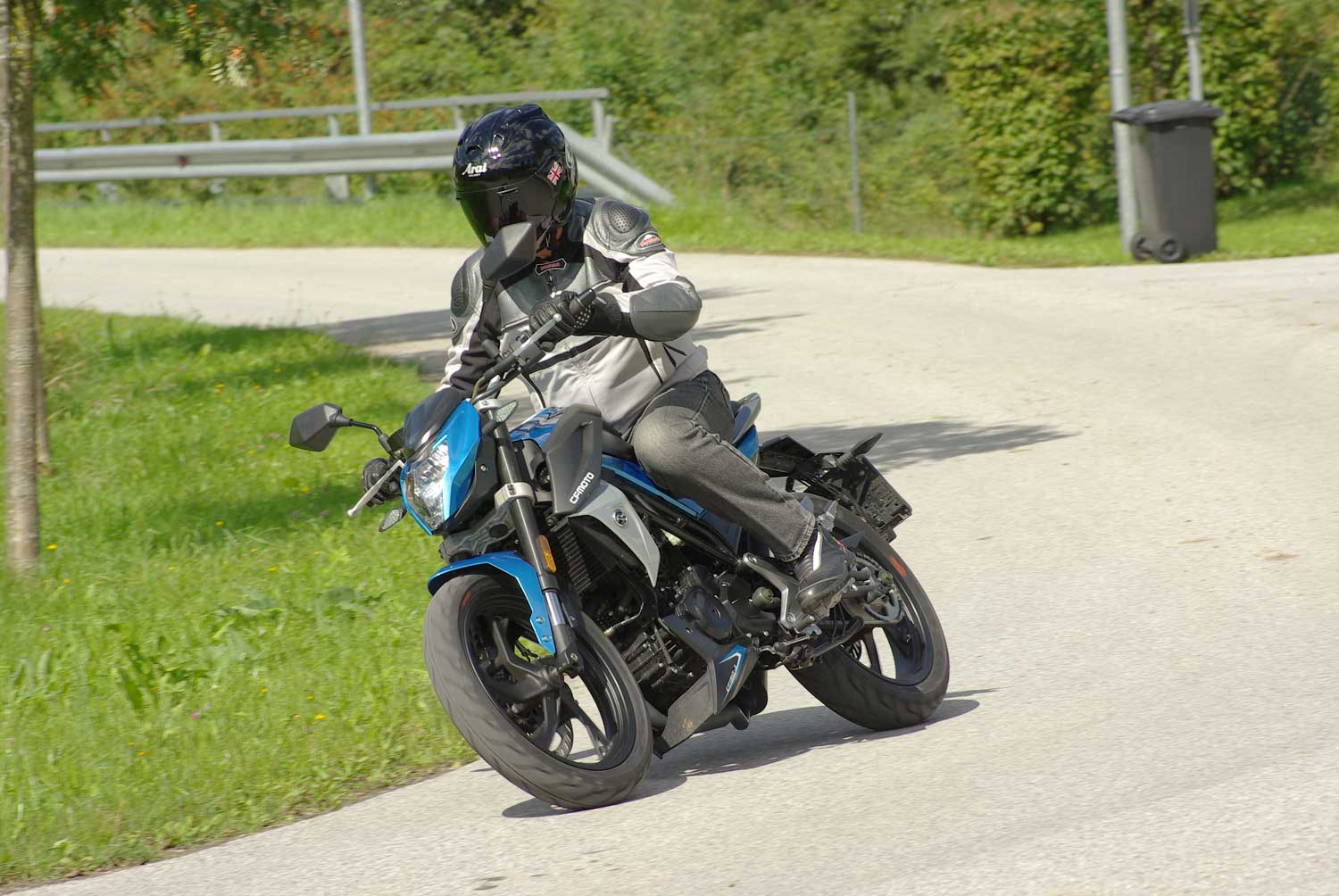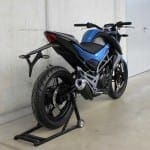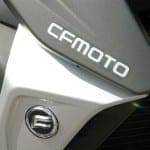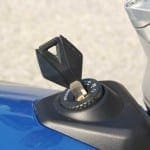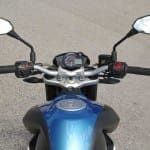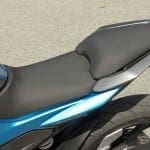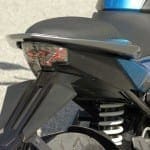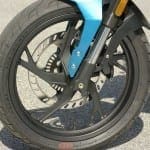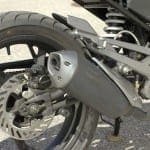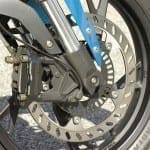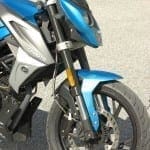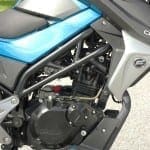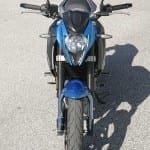CFMoto 650NK | €2000 (approx £1575) TBC | 149.4cc | 4-stroke single cylinder | 11.8bhp @ 8500rpm | 7.89lb-ft @ 7000rpm
Tested by: Alan Cathcart Photos: Kyoichi Nakamura
In 2009 Chinese company CFMoto began development – entirely in house – of its own purpose-built 650cc parallel-twin motor. This was to form a platform for a range of middleweight models of different types, of which the 650NK Naked roadster was the first. The 650TK hard-luggage Tourer came next and a 650AK twin-cylinder Adventure Tourer is expected to debut early in 2015.
It can now be revealed that this Adventure Tourer is being created for the Chinese manufacturer by Gerald Kiska, whose Austrian-based Design company has been responsible for producing every single KTM model since 1992.
CFMoto will debut the first of an all-new range of bikes with Kiska Design styling, powered by its own fuel-injected 150cc liquid-cooled overhead-cam six-speed single-cylinder motor at the Milan EICMA Show next month. A comparable 250-300cc model is believed to be under development, too, but it’s not thought to be likely to appear until the 2017 model year. We had an exclusive test ride of a pre-production version of the 150NK before the official launch…
Tell me about the engine
Though not up to the performance levels of KTM’s DOHC four-valve models even in 15kW guise, the 150NK’s Chinese-made SOHC two-valve engine producing 11.8bhp at 8500rpm, and 7.89lb-ft of torque at 7000rpm, is willing and completely smooth. Thanks to its gear-driven balance shaft there are no vibes whatsoever, even when fluttering the 10,200rpm rev limiter. This makes the new CFMoto easy to ride for any length of time, and the fact that its riding position didn’t feel cramped for a 5’11” rider like myself means that it’s a valid product for Western markets, not just Asian ones. Though easy and forgiving at low speeds in urban use, the engine has a fair appetite for revs, with the large red shifter light on the good-looking dash flashing at 8000rpm in every gear. It cruises happily at an indicated 62mph (100kph) with the big analogue tacho reading 8500rpm. I saw 74mph (119kph) on the digital speedo tucked well in going slightly downhill, and the CFMoto engine didn’t feel in the least bit laboured. That low-set Euro 3 exhaust – which even without a catalyst fitted is to my mind easily the most unlovely item on the bike – burbles away lustily, but is very quiet, so there’s lots of scope for an aftermarket system.
What’s the chassis like?
Kiska Design stylist Bjorn Shuster, who was responsible for detailing the 150NK and putting his boss Gerald’s concept into reality, has done a nice job of making the tubular-steel twin-spar frame into a design feature, as on a KTM or Ducati. He’s also done good work in hiding the radiators, without detracting from their efficiency.
Gerald Kiska is positive that CFMoto’s bike will become a key player in the global PTW market: “They understand how the domestic market in China is changing, where with motorcycles banned from cities, they have now become a leisure product that young people want to buy. But the big Chinese manufacturers can’t fulfil this demand, because such a bike has to look different and feel different to ride than the more conventional ride-to-work commuter models they produce – mainly copies of 1980s Hondas. This leaves a growing gap in the market which CFMoto has moved to exploit – and they’ve asked us to help them do that, knowing it can also help establish them in a new segment of the export market they’re not present in yet. The 150cc model had to be the first step on the capacity ladder for their customers, especially as they had an existing engine which could be modified slightly to suit, with a different exhaust and airbox. The chassis can be used to support several different variants of the same platform, just as the KTM Duke has now led to the full-fairing RC models, but CFMoto wants to evaluate the success of this first version before they move on to another sector. But this company knows how to build a reliable engine, which is the reason for their success in the ATV market. They understand they must train their staff properly, and that’s a key reason why they are able to insist on rigid quality control in production. Plus they understand brand marketing – they were the first to insist that their bikes are called CFMoto all around the world, when their competitors just care about shifting numbers, and let their importers call them what they like. So they are creating a brand, and that’s one thing we can help them do with a continuity of styling, like we’ve done with our friends just up the road. [KTM]”
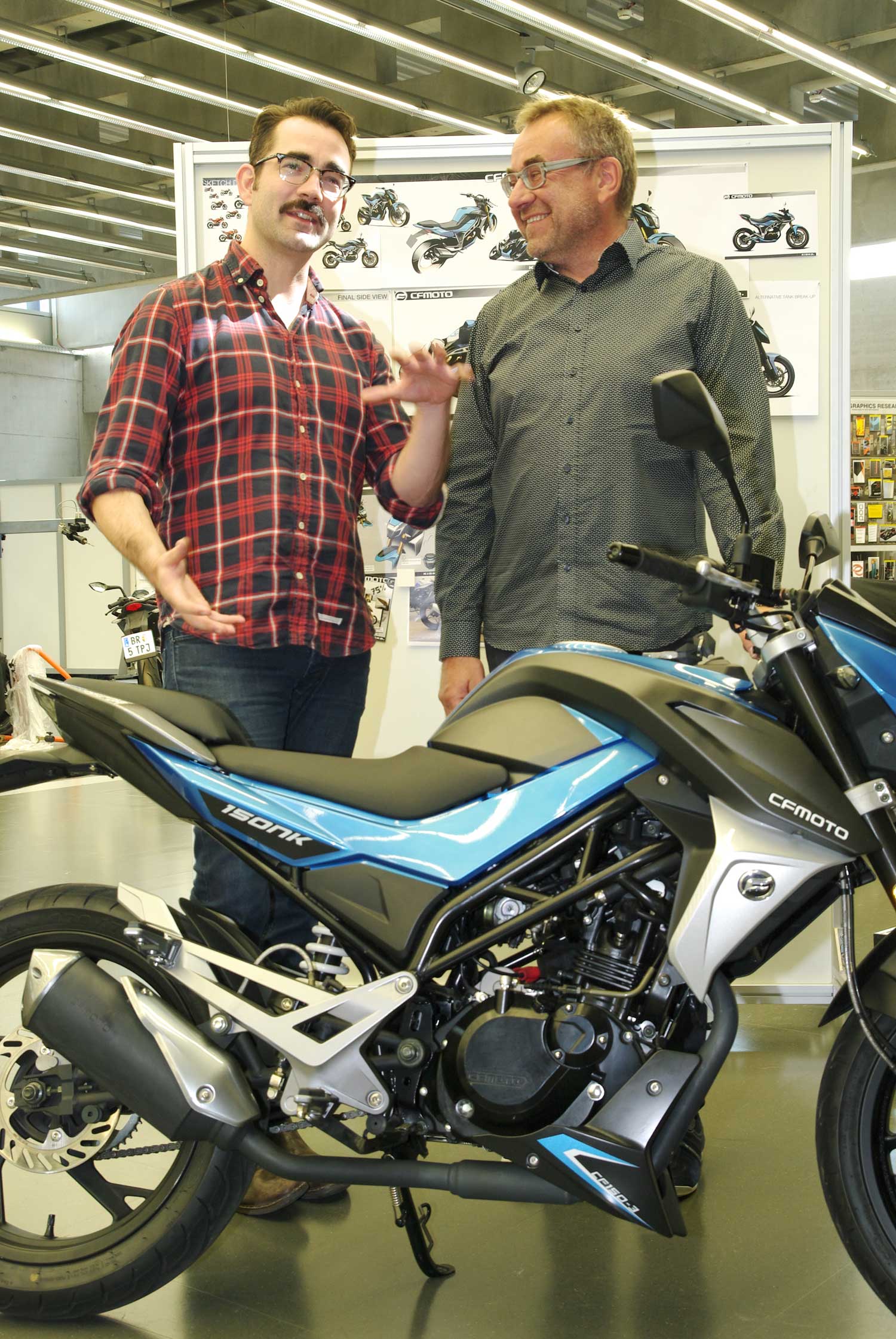
Should I buy one?
It’s a very dynamic-looking bike – the aggressive-looking headlamp cowl, the headlamp itself, the cast aluminium footrest hangers, and the good-looking cast wheels which are certain to end up on heaps of other bikes, thanks to their quality appearance. The whole package exudes substance – much more than you’d expect from a bike of this price – and coupled with desirable looks will appeal to teen dreamers who’ll be its likely target customers.
So what’s it like to ride?
The new single-cylinder bike has a strong visual identity, and appears pretty classy in the distinctive shade of aquamarine blue that Kiska has designated as CFMoto’s future house colour – well, it couldn’t be orange, could it? I regularly got waved at during my 150km ride round the Austrian countryside by Harley and BMW riders who would normally disdain acknowledging the existence of anyone on a Chinese-built budget bike… this comes over as a lot more bike for the money than its killer price leads you to expect.
On my return I took to the autobahn for a fast ride home, and found that the new 150NK will sit at an indicated 70mph (113kph) for mile after mile on level ground with the Sport map selected via the switch on the left handlebar, leaving Economy for use around town (which makes acceleration rather more sluggish but with reduced fuel consumption). The water temperature stayed constant on a 26ºC day at those speeds – just one-third of the way up the scale, – showing this is to be efficiently designed motor.
It feels more substantial than you’d expect from a 150cc runaround, yet it’s light-steering without being nervous. I could chuck the 150NK on its side into turns and still get the grip I hoped for. That good-looking frame handles well, albeit with adequate, rather than exceptional front suspension that isn’t particularly compliant over rough surfaces, though the rear cantilever monoshock gives better ride quality than I expected. Call it a score-draw.
The one-piece handlebar delivers a comfortable, upright stance that isn’t tiring, and the footrests are a little further back than usual for a bike of this kind, delivering a sense of sportiness that’s borne out by the way it steers so sharply. The brakes work really well, with two panic stops presenting an examination that I’m glad they passed each time. The single 292mm front disc looks skinny but has good bite, and judging by the ring already fitted is apparently ready for the ABS that CFMoto says it’s working on, for January 1, 2016 when it’ll be compulsory in Europe for bikes over 125cc in capacity.
The dash is legible and informative – more so than you’d expect from a bike in this category – with a digital panel showing fuel level, time, voltage, water temp and mileage plus a single trip, with warning lights on the left of the tacho. I’d have liked a gear indicator – as the Indian-built KTM Dukes have – to allow beginners to keep track of what cog they’re in on such a smooth, relatively torquey bike. It wouldn’t cost much, and would add to the 150NK’s perceived value – after all, it already has a choice of two engine maps. But fit and finish on this pre-production prototype (made in China, not a hand-built product of Kiska Design) was really excellent by any standards.
The trick will be for CFMoto to maintain that quality in series production, but after visiting its 150,000m² plant in Hangzhou last year and observing the series of quality control stations in action on the production lines, I’m confident that its 1,520-strong workforce can deliver the goods – it already has done so on the pair of 650cc twin-cylinder models. “The four vehicle assembly lines and three engine assembly lines operate a zero defect policy”, says the company’s Marketing Director, Samantha Liu. “If we want zero defects from one of our products, as we do, we realise we cannot afford to cut corners in quality control. Here at CFMoto we build up to a quality level, not down to a price, yet while still remaining competitive pricewise in the marketplace.”
The new 150NK is another major step in fulfilling CFMoto president Lai Guogui’s strategy to take the company forward, with a key step in that being the collaboration with Kiska Design. “Now that we have begun our collaboration with Mr. Kiska and are so pleased with the results, he will take care of all our motorcycle design in future – including refreshing the styling of existing models, as well as creating exciting new ones”, says Mr.Lai. “But you’ll have to wait to see what these will be!” I reckon that the 150NK is a pretty good start.
TECH SPEC
Price: £1575 / €2000 TBC
Engine: Liquid-cooled, SOHC, two-valve, single cylinder, four-stroke 149.4cc
Power: 11.8bhp (8.8kW) @ 8500rpm
Torque: 7.89lb-ft (10.7Nm) @ 7000rpm
Wet Weight: 142kg
Seat height: 785mm
Tank size: 10 litres


